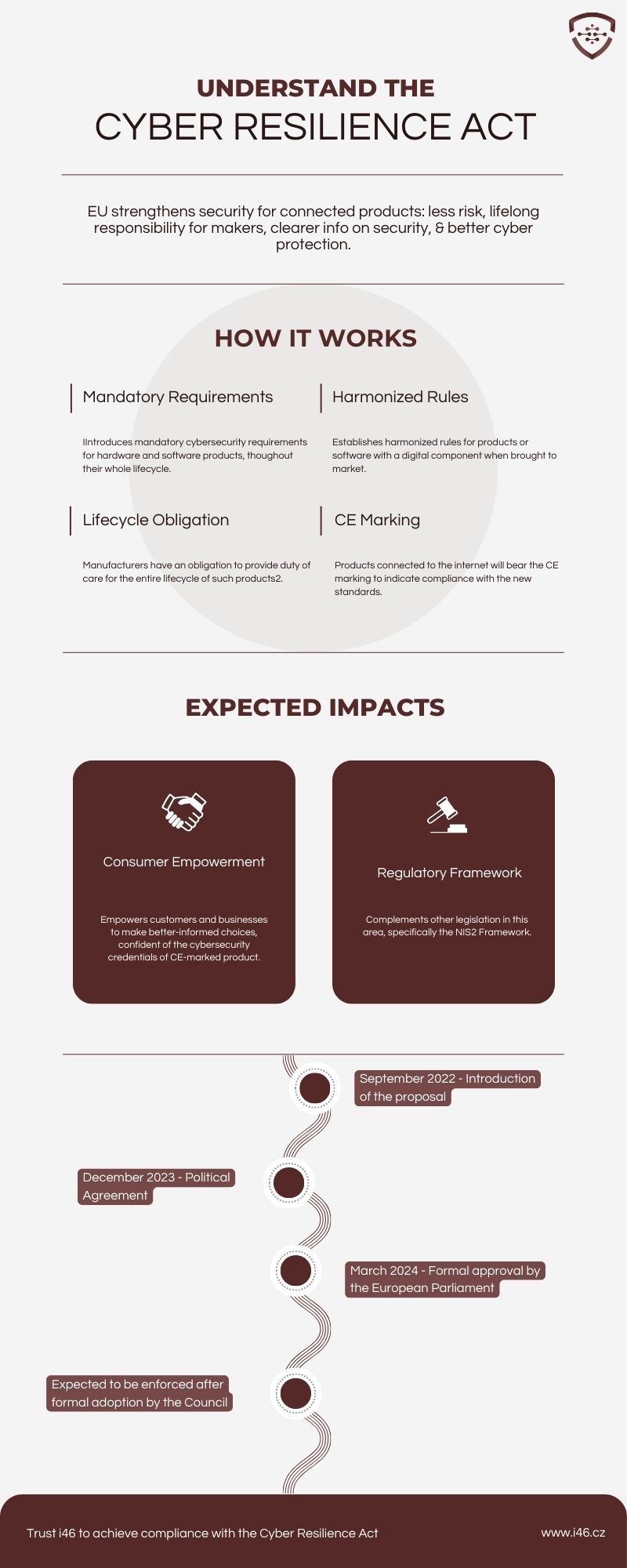The March 2024 draft version of the Cyber Resilience Act, explained
The Internet of Things (IoT) continues to revolutionize the way we live and work. From smart home devices to connected industrial equipment, IoT offers a world of convenience and efficiency. However, with this growing interconnectedness comes a heightened cyber risk landscape.
Enter the European Union’s Cyber Resilience Act (CRA), a proposed regulation aiming to strengthen security requirements for connected products. But what exactly does the CRA entail, and how will it impact businesses and consumers?
From the moment we wake up to a gentle nudge from a smart alarm clock to the automated lighting systems greeting us at work, connected devices are transforming how we interact with the environment around us. This ever-expanding network of smart devices, encompassing everything from fitness trackers to industrial control systems, offers a world of convenience and efficiency. Imagine a bustling city that manages resources more effectively, factories that optimize production automatically, and homes that adjust to our preferences in real-time – all thanks to the power of the IoT.
However, this interconnectedness comes with a hidden vulnerability: a heightened cyber risk landscape. Every connected device represents a potential entry point for malicious actors. A single vulnerability in a seemingly innocuous device, like a smart thermostat, can be exploited to gain access to a wider network, potentially compromising sensitive data or disrupting critical infrastructure. The interconnected nature of the IoT ecosystem creates a domino effect, where a single security breach can have far-reaching consequences. A compromised smart speaker in a home network could be used to launch a denial-of-service attack on a critical infrastructure system, or a hacked medical device in a hospital could put patient safety at risk.
Enter the Cyber Resilience Act: A Catalyst for Change
In response to these growing concerns, the European Union (EU) has proposed the Cyber Resilience Act (CRA). This landmark regulation aims to establish a robust framework for ensuring the security of connected products across the EU market. The CRA represents a significant shift in how cybersecurity is addressed within the digital landscape. Traditionally, the focus has been on the final product manufacturers. However, the CRA recognizes the interconnected nature of the software supply chain and the crucial role played by open-source code, which often forms the foundation of many commercially available connected devices.
The Act acknowledges that a secure digital future hinges upon a holistic approach to security, encompassing not just the final product but the entire supply chain, from open-source software development to post-market support. This collaborative approach is essential to address the complex challenges associated with securing the vast and ever-evolving IoT ecosystem.
The Core of the CRA: Building a Three-Pillared Fortress
The CRA focuses on three key pillars that act as the foundation for a more secure IoT ecosystem:
1. Essential Requirements: Establishing Minimum Security Standards
These mandatory security features are akin to the strong walls of a fortress, forming the first line of defense. Manufacturers must ensure their products meet these essential cybersecurity requirements, encompassing aspects like:
Secure Coding Practices: The Act emphasizes the importance of secure coding practices throughout the development lifecycle. This includes using well-established coding techniques that minimize vulnerabilities and employing vulnerability scanning tools to identify and address potential security flaws early on.
Vulnerability Management: The CRA mandates the implementation of robust vulnerability management processes. Manufacturers are required to have a system in place for identifying, classifying, and patching vulnerabilities in their products throughout their lifecycle. This proactive approach ensures that even if a vulnerability is discovered, it can be addressed promptly before it can be exploited by malicious actors.
Risk-Based Testing: The Act promotes a risk-based approach to security testing. Manufacturers are required to conduct thorough security testing of their products, focusing on areas with the highest potential risk. This ensures that critical functionalities are rigorously tested for vulnerabilities, while also optimizing testing resources.
These essential requirements establish a baseline level of security across the entire IoT market. By requiring all connected devices to meet these minimum standards, the CRA effectively raises the bar for security within the industry.
2. Harmonized Standards: A Blueprint for Secure Development
Imagine a set of blueprints for building robust defenses. The Act promotes the use of harmonized cybersecurity standards, providing a clear and consistent framework for compliance across the EU. These standardized guidelines ensure all manufacturers are building their devices with the same level of security in mind, eliminating confusion and creating a level playing field for businesses.
The European Commission, in collaboration with relevant stakeholders, will develop these harmonized standards. These standards will be based on existing best practices and industry-recognized frameworks, ensuring that they are practical and effective for manufacturers to implement. By leveraging these harmonized standards, manufacturers can gain clarity on the specific security requirements they need to meet, streamlining the development process and ensuring consistency across the industry.
3. Market Surveillance: Vigilant Guardians of Security
Just as a well-defended fortress requires vigilant guards, the CRA empowers regulatory authorities with enhanced powers to oversee the market and take action against non-compliant products. This includes:
Security Champions: They are responsible for identifying and addressing potential security weaknesses within the open-source code. This proactive approach strengthens the entire IoT ecosystem by ensuring that the foundational building blocks upon which many connected devices rely are secure.
Community Leaders: Stewards foster a vibrant community around the open-source project. They attract new developers, cultivate a culture of collaboration, and secure resources to ensure the project’s continued health and active maintenance. This not only benefits the project itself but also strengthens the overall open-source ecosystem by encouraging participation and innovation.
Bridges Between Stakeholders: Stewards act as a crucial link between developers, policymakers, and industry players. They can advocate for the needs of the open-source community within the regulatory framework established by the CRA, while also ensuring that developers are aware of security best practices and industry expectations.
Stricter Product Testing and Certification: Regulatory bodies will have the authority to conduct more rigorous testing of connected devices before they are placed on the market. This ensures that only devices that meet the essential requirements and harmonized standards are available for consumers. Additionally, the CRA paves the way for mandatory product certification schemes, providing an extra layer of assurance to consumers about the security posture of the devices they purchase.
Enforcement and Corrective Measures: The Act grants regulatory authorities the power to take enforcement actions against manufacturers who fail to comply with the regulations. This could include fines, product recalls, or even market bans for non-compliant devices. These enforcement measures serve as a deterrent against non-compliance and incentivize manufacturers to prioritize security throughout the product lifecycle.
Information Sharing and Coordination: The CRA fosters improved information sharing and coordination between regulatory authorities across EU member states. This allows for a more unified approach to market surveillance and ensures that vulnerabilities are identified and addressed swiftly on a pan-European scale.
Expected Impacts: A Brighter Future for the IoT
The CRA is anticipated to bring about several positive changes that will benefit both businesses and consumers:
Increased Security: By setting stricter security benchmarks, the Act aims to significantly reduce the vulnerability of connected devices to cyberattacks. This translates to a more secure digital environment for everyone, fostering trust in the technology and mitigating the risks associated with a compromised IoT ecosystem. Businesses will benefit from a more secure supply chain, reducing the likelihood of costly security incidents and reputational damage.
Improved Transparency: Manufacturers will be required to provide clearer information about the security posture of their products. This transparency empowers consumers to make informed choices about the devices they purchase, allowing them to select products that align with their security needs. Imagine a label on a smart device that clearly outlines its security features, any potential vulnerabilities, and the manufacturer’s commitment to ongoing security updates. This transparency fosters trust between consumers and businesses within the IoT landscape.
A Level Playing Field: The harmonized standards will ensure a fair and competitive market where security doesn’t take a backseat. By establishing a consistent set of guidelines, the CRA eliminates the potential for manufacturers to cut corners on security to gain a competitive edge. This fosters a more responsible and trustworthy environment for all stakeholders within the IoT landscape. Smaller businesses will benefit from having clear guidelines to follow, reducing development costs and complexity associated with security compliance.
A Catalyst for Innovation: The CRA, while emphasizing security, does not intend to stifle innovation. The Act is designed to be flexible and adaptable to accommodate the ever-evolving nature of the IoT landscape. This allows businesses to continue innovating and developing new connected devices while adhering to robust security standards.
The Role of Open-Source Software Stewards
The inclusion of the open-source software steward concept in the latest version of the CRA represents a significant step forward. Open-source software plays a vital role in the IoT ecosystem, forming the foundation for many commercially available connected devices. The steward acts as a dedicated guardian for a specific open-source project, ensuring its continued security and functionality for commercial use.
Stewards play a multi-faceted role, acting as:
The collaboration between open-source software stewards, manufacturers, regulatory authorities, and consumers is essential for building a truly secure and thriving IoT ecosystem.




